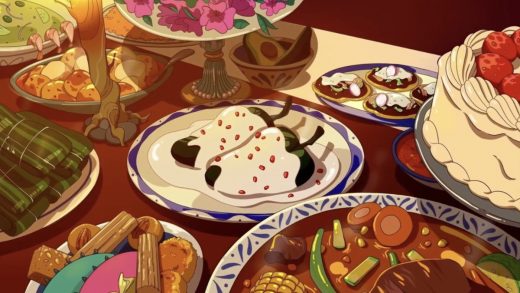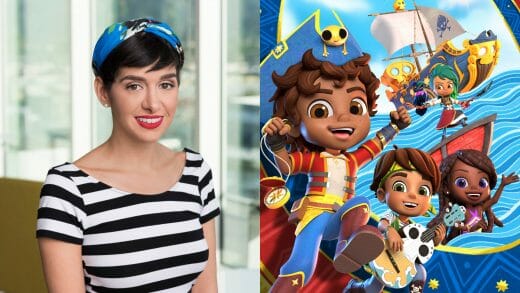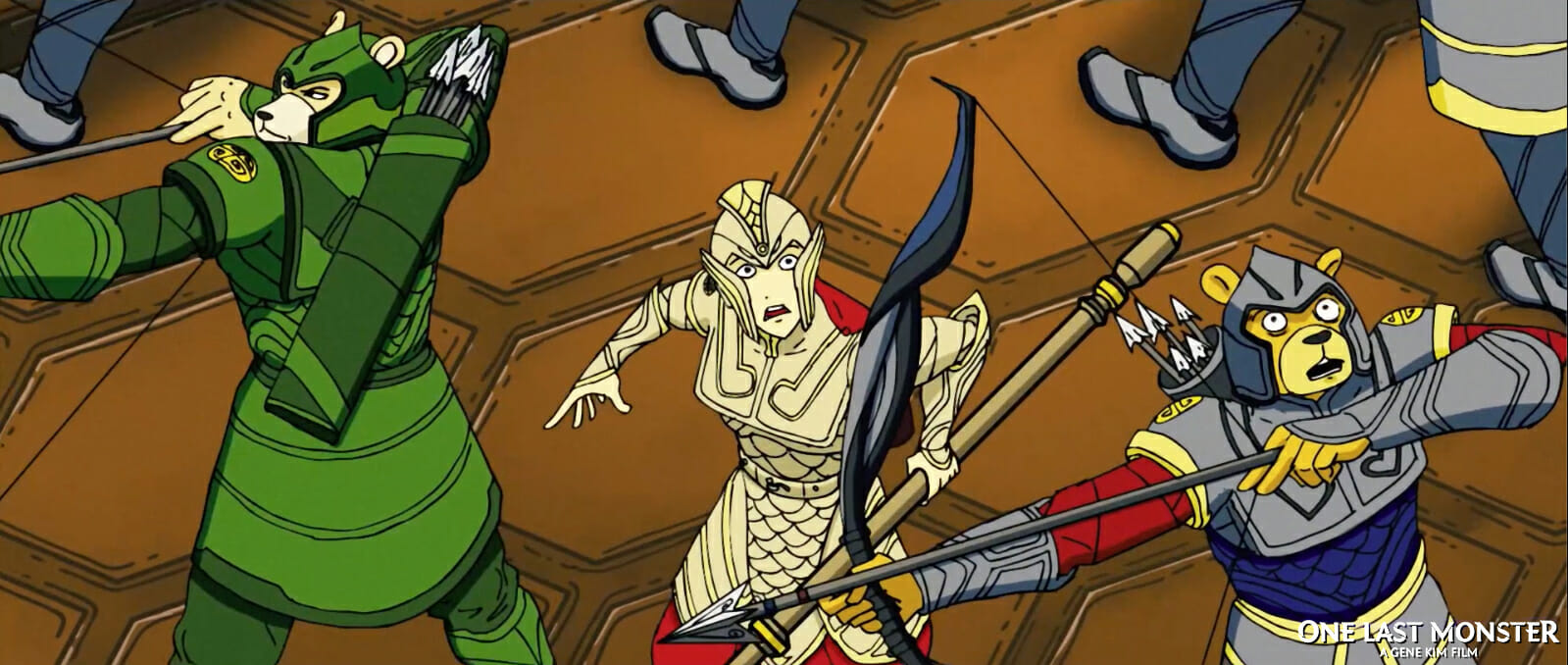
Have you ever thought about creating your own epic fantasy series? One Last Monster is an independent short film which follows Empress Eura as she seeks to protect her birthplace from mysterious alien assailants. Born from the mind of director Gene Kim, the film is set in Adin; a fantasy world with rich lore and worldbuilding. Understandably, such a universe requires a thoughtful approach to bring it to life.
Fans of anime will find familiar hallmarks in Adin, but the strongest influence on One Last Monster draws from Gene’s interest in Korean history. Visual references to the Joseon dynasty ground the world of Adin with a sense of depth and realism. For example, the character of Taejo was inspired by Joseon’s 14th century emperor, with design cues borrowed from traditional portraiture.
Gene Kim used a variety of techniques to enhance the atmosphere of his animated universe. While created digitally using Toon Boom Harmony, One Last Monster’s style is inspired by traditional anime cels. In the spirit of early anime, Gene and co-animator Elmer Barcenes rely on strong layouts throughout the film’s 23-minute runtime to create a story that feels much grander in scope than the time and resources at their disposal. Read our full interview below to learn about Gene Kim’s experience making One Last Monster.
Congratulations on all of the accolades so far. In your words, what is One Last Monster about?
One Last Monster is a fantasy action-adventure story that takes place in a world inspired by Korean history. The story centers around one difficult decision that the brave but imperfect Empress Eura Adin must make, which could save or destroy her world. Adin has been invaded throughout its history by mysterious alien attackers. So Eura’s late husband, Emperor Taejo, developed magic defense weapons to protect Adin.
What does Eura do then when one day, a giant alien monster named Didas, who looks like yet another alien attacker, comes to Adin with an apocalyptic warning about those very weapons? Does she trust Taejo’s work or the enigmatic and threatening Didas? Eura must make a decision. So she and a band of other heroes set off on an adventure with Didas across Adin to learn more.
At the core of One Last Monster is the idea that sometimes what we think will be good for us can actually turn out to be bad for us. Conversely, what we think will be bad for us can actually turn out to be very good. So I’d like to think that Monster is a story about the danger of never leaving your comfort zone. But also how hard it can be to acknowledge and accept those dangers.
How would you describe the art style in One Last Monster?
I’ve always been a fan of more realistic anime art styles. One big thing I remember hearing repeatedly in college from all my professors was how important life drawing and traditional draftsmanship is. I grew up an anime fan as well. So I think my art style is a middle ground between what my professors wanted and the anime I grew up with.
While I love cartoon-style projects too and have since worked on several as a storyboard artist, realistic anime always feels like home to me. Films or shows with this style that come to mind are Cowboy Bebop, Macross Plus, the video game Overwatch or any of the Final Fantasy games. Some 80s/90s anime influence there too via Robotech/Macross, Rurouni Kenshin, Evangelion, Gundam, or Princess Mononoke. I’m 34 and so I feel lucky that we got to watch all these shows as kids growing up in the late 90s and early 2000s on Cartoon Network, The Sci-Fi channel, and even on VHS tapes sometimes!
Pushing the retro anime look, I threw in film grain and added 35mm-style color correction filters in DaVinci Resolve to subtly make the film feel like an anime that was created on cels and photographed on 35mm film as opposed to created all digitally. There’s just this vintage, otherworldly and atmospheric quality to anime produced that way that I can’t quite describe with words, but I do miss it — as much as I love recent anime too.
Please introduce the main characters we meet in One Last Monster…
The main character of this story is Empress Eura Jo. She is a great fighter, compassionate leader and desires to do the right thing. But her relative inexperience and the alien invasions she’s witnessed cloud her judgment.
You then have Emperor Taejo, Eura’s late husband. He is willing to do anything and go to any length to defend Adin from the invaders. Taejo is a quiet, determined and wise ruler who projects great calm and certainty about all his decisions. Even if they are morally questionable.
Finally there is Didas. Upon first glance, he is meant to look like a typical giant evil monster villain but as the story progresses, you realize that he is a far more complex character than just a Godzilla-sized city smasher. I fear to say any more would spoil the story, but Didas was so much fun to write. I wanted to subvert and lovingly poke fun at kaiju and anime tropes.
What did you consider when approaching their character design?
I like to think that Eura is in some way the older historical sister of the Korean character D.Va from the game Overwatch. Both are smart but are skilled warriors as well. Queen Seongdeok of the Korean Silla dynasty (632-647 AD) also wore red robes and was probably the closest thing Korean history has to a real-life Empress Eura. She isn’t a shonen or shojo character but older, in her early 30s. Giving her that action-adventure energy but also stately maturity and somberness was interesting.
Taejo is based on an actual Korean king named Emperor Taejo (1355-1408) who lived during the historical Korean Joseon period. He was meant to be extremely realistic and not as anime-inspired, in order to evoke the gravity of traditional Korean paintings of kings.
Didas just had to look like a big meanie as much as possible, so that audiences would initially think of him as the villain. There’s definitely a lot of Mobile Suit Gundam influences in his design. There was another robot from a relatively obscure 90s anime called Gasaraki that was a huge influence on his design too. Initially I wanted to make Didas red to give the initial impression that he was a demon but I realized that the monster in the One Last Monster title ultimately refers to Eura, not Didas, and it is ultimately her story. So I switched Didas over to blue.
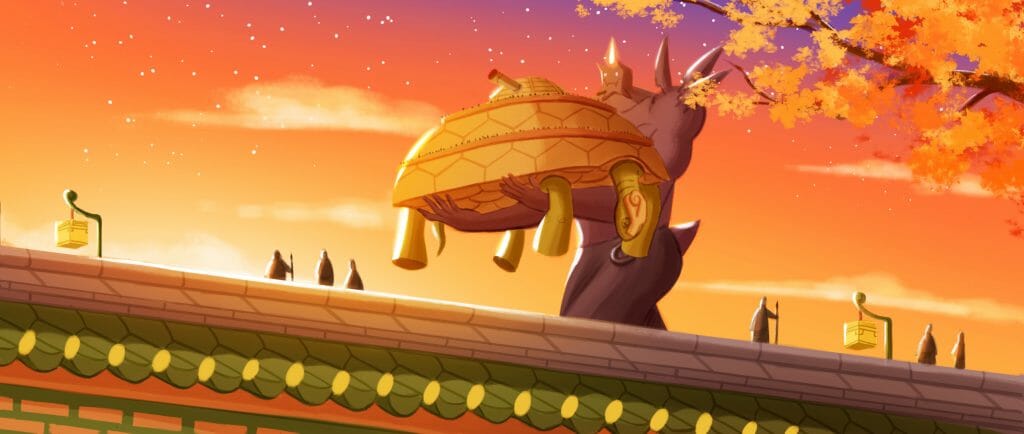
Can you tell us about the process of storyboarding the original ideas?
I’m a big believer in thumbnailing your boards extremely rough on paper, on the actual script pages, and then moving onto drawing the boards digitally. It was very hard but I tried to suspend my inner critical voice and judgment to allow my ideas to flow and be corrected later. I am indebted to the incredible storyboard artist and former NYU professor, David Zung, for his feedback and notes during the writing and boarding process of Monster.
David was really great at getting at the essence of the story. The first drafts of the script were all over the place and had too many competing ideas. But David essentially encouraged me to make this story about a character making an important decision; torn between two unclear options.
The other big consideration was that I knew I could let my imagination run wild but, at the end of the day, this would all have to be animated by myself and my wonderfully talented friend and co-animator, Elmer Barcenes. Elmer had previously worked on a number productions at Titmouse and introduced me to Toon Boom Harmony. We both animated the entire film in Harmony over the course of almost two years, with the help of a number of colorists.
We had to be strategic and kept things simple using puppeting, emphasizing the detail of layouts and background art and using a whole suite of limited animation techniques. This actually helped it feel even more like an 80s or 90s television anime. Harmony was perfect for this workflow and we are both still extremely proud of how everything looks. I’m also really proud that we were able to maximize what we had and create a story that feels much bigger than the minimal resources, time and manpower we actually had.
Tell us about Adin. What is the look and feel of the planet?
Joseon Dynasty era Korea, from 1392 to 1897 AD, was the main inspiration for everything in Adin from costumes to buildings and ships. I am a Korean-American and creating Monster was a great opportunity for me to learn more about my culture. The giant turtle tank is a reference to the real-life wooden turtle boats that Admiral Yi Soon Shin invented to defend Korea from Japanese invaders in the 15th century. The fortress city we see in the film is inspired by the Suwon Hwaseong Fortress, south of Seoul. There’s tons of beautiful color, woodwork, patterns and intricate design in historical Korean culture and it’s all visually mesmerizing.
We also wanted to be imaginative. In that spirit, my fantastic visual development lead, Eileen Kim (who now works at Nickelodeon), and I had plenty of room to take liberties. Our costume design takes traditional Korean hanbok clothing but simplifies some elements of it for animation while also adding new elements. The armor design as well was based on statues of the animal zodiac that you can see at some historical sites in Korea. But again with an eye on streamlining designs for animation and exploring new visual possibilities.
I should note that you don’t often see many depictions of Korean culture outside of Korea. This was a really interesting challenge, as I often had to take inspiration from elsewhere to fill gaps in. The Adinian building roof shapes are inspired by door gates I saw in Barcelona, Spain. Tang Dynasty China and epics like the Chinese Journey To The West and Romance of the Three Kingdoms were also a major help, as I am a huge fan of wuxia and kung fu movies and they are just visually electric. Lastly, I was really inspired by how Overwatch handled its Korean history-themed character skins and it was a confirmation that Korean culture is a wonderful sandbox to play in.
What was the process of voice acting for the animated scenes in One Last Monster like?
Really fun! I studied live-action filmmaking as a hobby in high school and in college and it reminded me of the energy of being on set, supervising an ADR session for animation. My co-animator Elmer was instrumental in helping me cast talent for the voices. We just both felt that once the actor had a gravity, and we could picture them embodying and lending weight to whatever the character was, they’d be in. I’m a highly collaborative person and so I encouraged the actors to bring their own creativity and contributions to their performances. And I think they all elevated the material.
Our current voice actor for Empress Eura, the incredible Korean-American actress Susan Elle, brings all the intelligence, grace and fun in the character I could have ever wanted from the role. All I have to do was just sit back and let her do her thing.
I also have a very minor role as the voice of Prime Minister Oolong the rabbit. It was pretty surreal for my friends to see a grown man meowing in a sound studio. Perk of the job, I suppose.
What advice do you have for storyboarders looking to build a world of their own?
When it comes to environment and prop design, I am a big fan of walking around the neighborhood and trying to find interesting shapes in anything — stones, pipes, grass, trees. I take photos of one of these shapes and then re-draw them as a building, vehicle or even a character. It just trains you to find inspiration organically with what’s around you. I also love whenever I’ve been able to travel, as I find new places incredibly exciting and interesting. Similarly, exploring and researching different periods in history and different cultures, folklores and mythologies does the same thing for me and is a great way to spark ideas.
I would also check out the Myst and Riven games. Without really using any human characters and just purely by building lore, environments and prop design, they’re able to create a compelling narrative that has captured gamers for decades now. I’m a lifelong fan of the Myst series and it’s amazing, as a child playing the game on CD-ROM, how magnetic the mystery and atmosphere of its worlds were. The games were really good examples of how important it is to think about little details.
While making Monster, I read a lot about how George Lucas made Star Wars and I love that he mashed up all his favorite films, tv, sci-fi stories and created something new. I think it speaks to the importance of watching stuff that isn’t anime or animation, going out and trying new things and widening what influences you. I ran the NYC Marathon during the making of the film and found it almost as natural, and sometimes as painful, as animating!
Finally, I would borrow a piece of advice from Robert McKee, who wrote Story, and Dean Moshovitz, who wrote Pixar Storytelling, and absolutely make sure that your story has three levels of conflict: physical conflict, relational conflict and inner conflict inside the hero or heroine. If you just have things exploding and don’t explore how the relationships between characters or the main character’s worldview changes, or doesn’t — you have a pretty thin story.
The inner conflict aspect is something I resonate with deeply. I feel attached to characters that struggle but also feel emboldened and inspired when those characters change and overcome those struggles. Lord Of The Rings, Star Wars & Crouching Tiger, Hidden Dragon and The Incredibles were all influences on Monster for this reason. And are some of my favorite films. I was also very inspired by how these films told their stories of struggle against the backdrop of fantastical and epic worlds that captured the imagination. It’s combining style and substance and I try to do the same with everything I create.
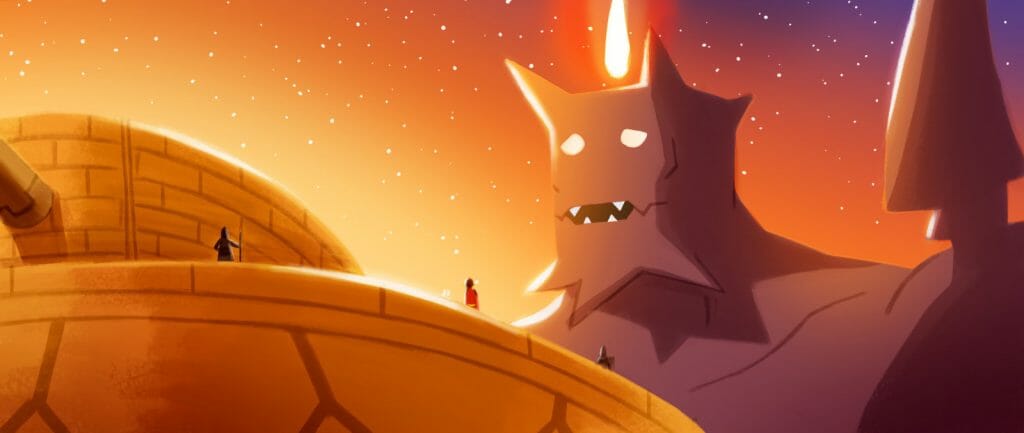
- Interested in learning more about One Last Monster and the world of Adin? Visit the short film’s official website.
- Looking for more stories about creators who seek to expand the scope of animation? Read more articles in Animation From Every Angle.


